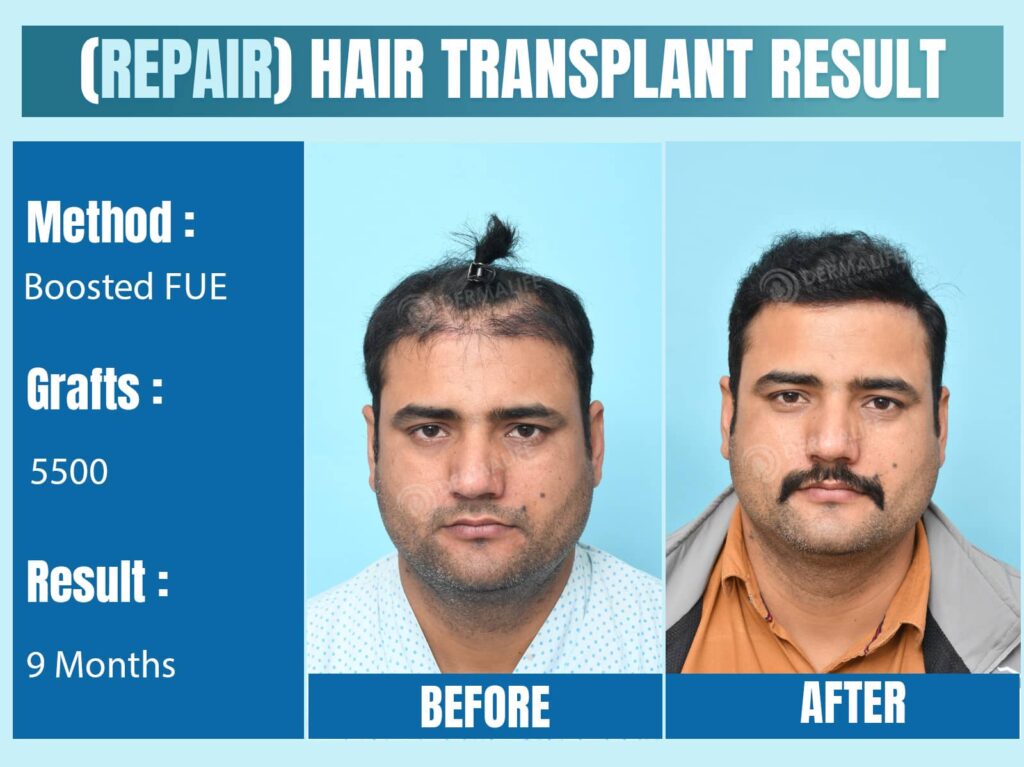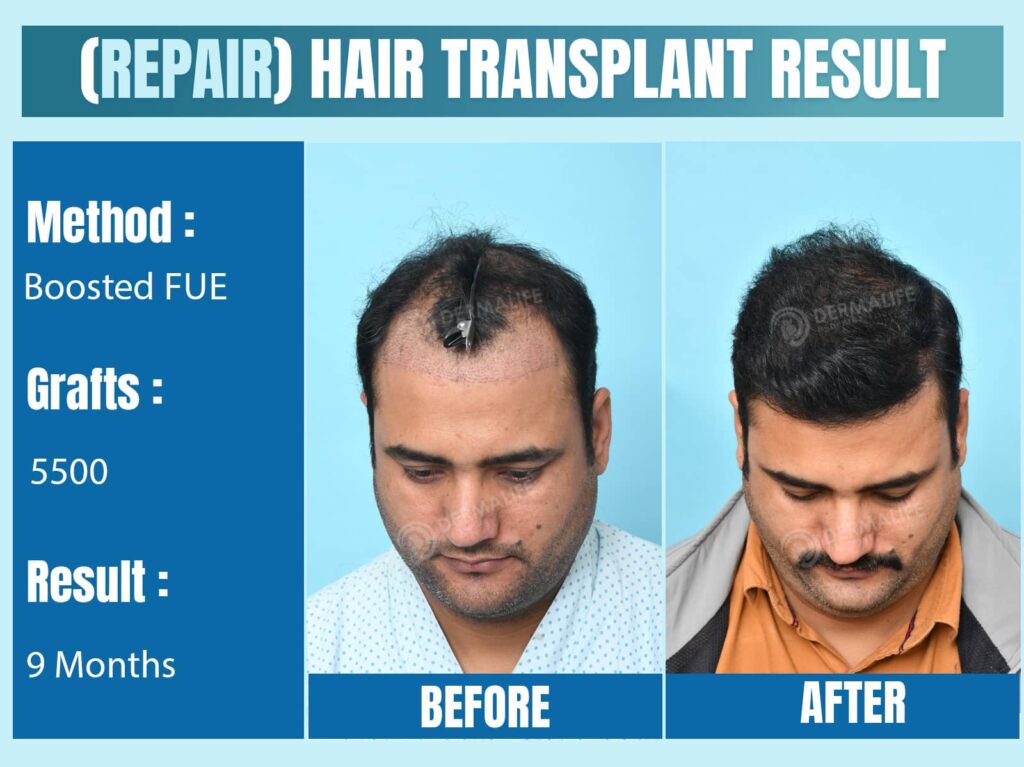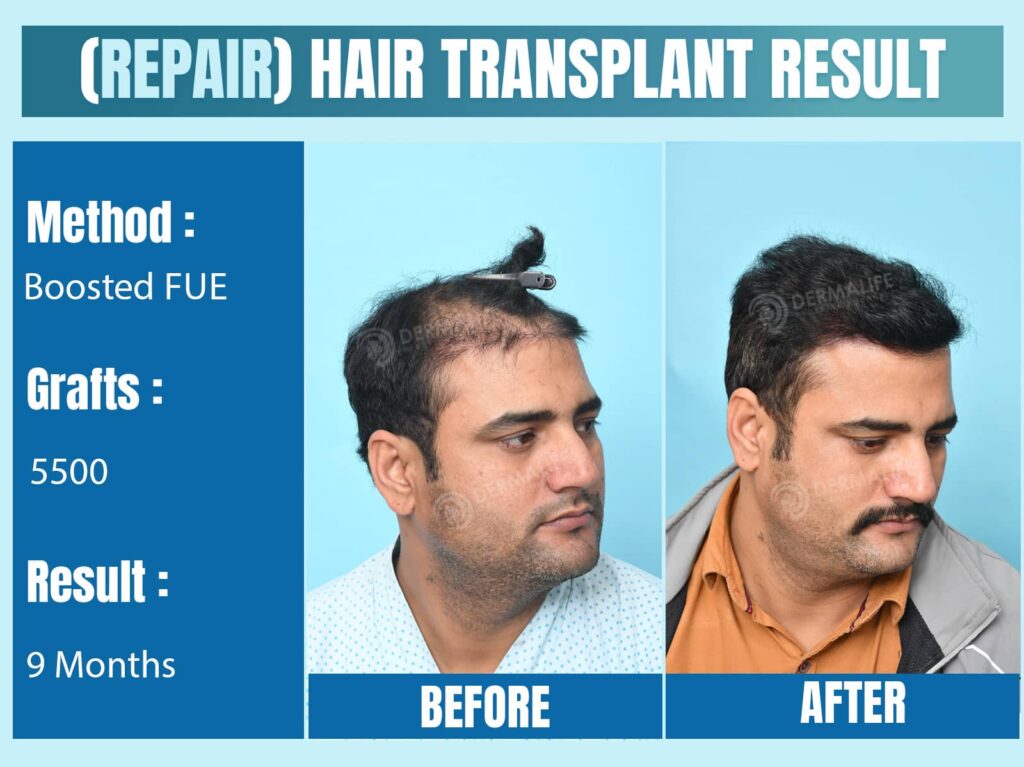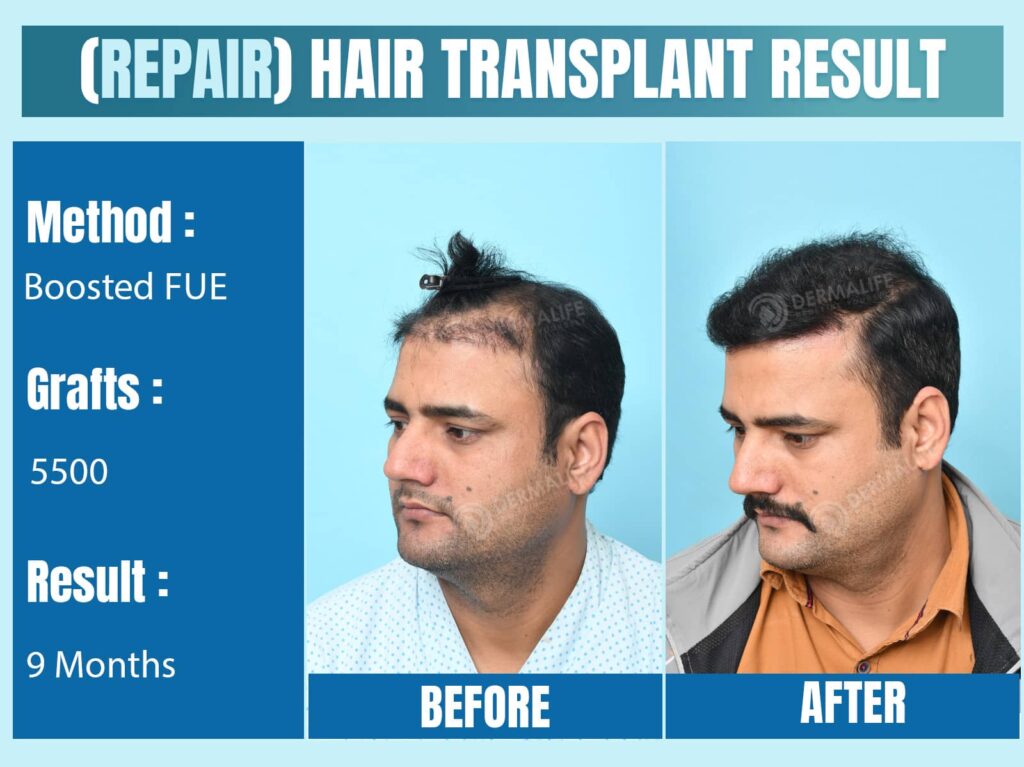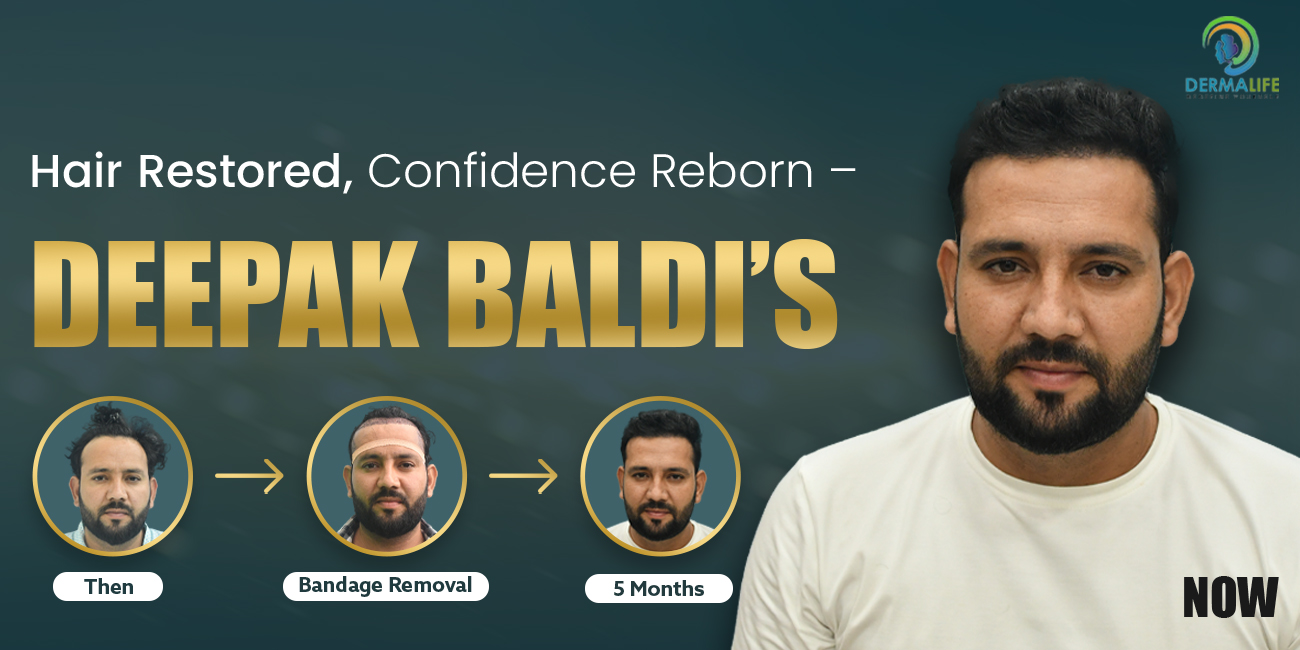‘Your hair journey starts with us’ Dermalife
People are losing more hair than ever before due to increased stress and lifestyle issues. Hair is one of the most important aspects of a person’s overall appearance and personality. Numerous people experience frustration and embarrassment when they lose their hair at an early age or even in their forties. As a result, more and more people opt for hair transplant surgery which is a relatively long-lasting treatment for hair loss.
In most cases, the hair transplant procedure is a success, and the patient returns with natural-looking, healthy, thick hair. However, hair transplant surgery might fail in certain situations owing to a variety of causes. But, an unsuccessful hair transplant does not mean that there are no other options left. There are several treatments and strategies available for correcting a botched hair transplant operation.
Today, we’ll go into detail about what is a failed hair transplant surgery and its corrective procedure.
Table of Contents
Feel free to skip ahead if one topic catches your eye:
- What is a Failed Hair Transplant?
- What are the Hair Transplant Failure reasons?
- Signs that show a Failed Hair Transplant
- Who are considered good candidates for Hair Transplant Revision surgery?
- Remarkable ways to fix a Failed Hair Transplant.
- What is the Cost Involved in Repairing a Failed Hair Transplant?
- How to find a Reputable Hair Surgeon who can correct a Bad Hair Transplant?
Takeaway
- What is a Failed Hair Transplant?
During hair transplant surgery, hair follicles from the healthy portion of the scalp are removed and transplanted into areas with thinning hair follicles or bald patches. If everything goes well, the results of hair transplant surgery are quite natural, and when done under the supervision of a skilled hair transplant surgeon, the follicles are implanted uniformly, giving a very natural-looking appearance.
When a hair transplant fails, the outcomes are not as natural as planned or predicted at the beginning. After the hair transplant procedure, the hair begins to fall out in large quantities, and the hair may grow in patches, with some visible bald patches.
A well-done and successful hair transplant surgery is nearly undetectable. When done incorrectly, however, anybody can quickly detect or point out that you have had surgery since the results are highly unnatural and artificial-looking. Hair does not grow as it should, which is one of the most common signs of a failed hair transplant.
- What are the Hair Transplant Failure reasons?
There are several reasons which can lead to the Failure of a Hair Transplant surgery:
- Less experienced surgeon: Hair transplant surgery is an extremely difficult process that requires extensive expertise and a highly skilled hair transplant specialist. A hair transplant surgeon who is unskilled and untrained might cause more harm than good. The surgery necessitates a comprehensive grasp of the method as well as a good technique while doing operations such as cleaning the graft site and inserting the hair follicles. Using proper extraction techniques and transplantation of donor hair follicles is very crucial. One of the most essential things to remember before undergoing hair transplant surgery is to speak with an experienced and competent hair transplant surgeon.
- Improper handling of the hair grafts: When hair follicles are removed from the donor location, they are not immediately implanted. The time between extraction and implantation is one of the most important defining elements in the outcome of hair transplant surgery. Following extraction, the follicles must be preserved properly and taken care of to preserve their viability.
- Drying of grafts: Following the extraction, the grafts are put in a psychological bath solution before being transferred to the recipient location. If the grafts are removed and left on a contaminated surface or exposed to air, they will dry out. Dried grafts will not be viable and will result in a failed surgery.
- Not properly implanting the grafts: Another precaution before undergoing hair transplant surgery is that the graft should be properly inserted into the recipient’s location. The major goal of hair transplant surgery is to provide the patient with a natural-looking outcome. Therefore, the hair follicles should be transplanted in such a way and angle that they imitate the growth of natural hair. When hair graft implantation is not done correctly, the chances of failure rise.
- Too deep or too shallow graft placement: Hair follicles are found in the scalp’s dermis. They exist at a specific depth, and if the head grafts are placed too deep, they will have a difficult time growing properly, perhaps leading to the failure of the head transplant operation. If the depth is too shallow, the hair will be easily pulled.
- Failure to follow through on post-operative care: It is critical to take proper care of the surgical site following the procedure. It determines your hair’s health as well as the effectiveness of the hair transplant. It is essential to follow your doctor’s instructions for post-operative care.
- Signs that show a failed hair transplant
The following are common indications of a failed hair transplant:
- An unnatural-looking hairline and hair growth. patchy and inconsistent hair growth.
- The hair growth seems to be uneven, and there are noticeable scars. A botched hair transplant also leaves a lot of scars behind, which are very visible.
- The surgery fails to offer adequate coverage and there is an increase in the loss of transplanted hair follicles. Some hair loss following head transplant surgery is normal and is commonly referred to as shock hair loss, but if there is significant hair loss even after months of undergoing hair transplant surgery, it indicates that the transplant might have failed.
- The density of the hair diminishes, making the hair look extremely thin. The hairline seems to be receding and looks artificial.
- Hair transplant surgery is similar to creating art. The hair surgeon should know where to place more grafts to give the region a thicker look and where to place fewer grafts to make them look more natural. The temporal area generally has less hair, which blends nicely with the skin on the forehead. When a hair transplant is performed by an unskilled individual who does not understand how to balance these proportions, you may end up with bushy temples where the head seems thicker around the forehead, which can result in a very poor appearance.
- Who are considered Good Candidates For Hair Transplant Revision Surgery?
Another major cause of hair transplant surgery failure is the candidate’s compatibility. Hair transplantation, like many other treatments, is not for everyone. Several elements influence success. The specific factor that qualifies you for a revision hair transplant surgery:
- Age: When it comes to being able to go for a revision hair transplant surgery, age is an essential consideration. Patients above the age of 25 are typically considered suitable for the operation. If you are under the age of 25, your hair may still be in the growth phase, and the donor site may not be stable enough for a successful transplant. If a patient has a hair transplant in the early stages of baldness, the baldness can worsen with time and the hair transplant operation may fail.
- The donor area’s stability: Hair loss occurs as a result of a process known as shrinking, in which the hair follicle shrinks as a result of a hormone known as dihydrotestosterone. This shrinkage of hair follicles results in hair loss and baldness. Before performing hair transplant surgery, it is important to thoroughly assess the stability of the donor region, since if the donor area is too thin, the appearance of scars after the procedure could be evident.
- Patients who are eligible for FUE hair transplant surgery: The FUE transplant is an advanced method in which each hair is removed separately from the donor site and implanted into the recipient site. One of the main benefits of FUE is that it is a highly accurate and precise procedure that does not affect adjacent hair follicles and the scars are pretty negligible. Patients who undergo follicle extraction are reported to heal faster and have a higher success rate in hair transplantation operations.
- The scalp health: Overall hair quality, hair texture, and scalp health are all significant considerations. A healthy body and scalp tissue will undoubtedly provide greater results after a revision hair transplant surgery.
- There are no long-term health issues: If you have any long-term health issues, such as diabetes or high blood pressure, it is typically recommended that you first consult with a hair transplant surgeon before undergoing a revision hair transplant surgery.
- Remarkable ways to fix a Failed Hair Transplant
Surgery is an extremely stressful procedure in and of itself, but when it fails, it becomes even more challenging. But, when you visit a cutting-edge clinic like dermalife, your chances of hair transplant surgery failure are reduced owing to the presence of highly specialized experts as well as modern technology.
But, if you have previously undergone a hair transplant surgery that failed, there are several astonishing techniques to repair a failed hair transplant operation.
- Graft excision/Plug removal: In the case of uneven density, follicular unit extraction can be used to extract individual hair graft transplants and then impact them into the less dense regions. The density in bald regions can be increased by redistributing hair grafts from the area where they are in excess and then implanting them equally all over the scalp. This procedure helps restore the problematic grafts and gives a more natural appearance to the hair
- Redesigning the hairline with FUE: Uneven or sparse hairlines can be corrected by utilizing the follicular unit extraction procedure to properly design the hairline. When hairlines are not correctly pre-designed, they might result in uneven and artificial-looking hairlines. This is generally fixed by reshaping the hairline using FUE and individually placing each hair till the desired shape is achieved.
- Scalp micro pigmentation: A poorly done follicular unit transplantation might result in visible linear scars following the procedure. Scalp micro pigmentation is used to hide surgical scars. During the scalp pigmentation method, similar-looking natural pigments are applied to the scalp, mimicking the visibility and appearance of the genuine hair follicle.
- Combined repair: In this procedure, the larger grafts that are saturated in one location are removed, dissected, and individually put into the donor area to create a more realistic look. Then sophisticated camouflage methods are used to provide a natural appearance.
- Laser Treatment: In the case of smaller hair follicles, laser treatment is used to remove and extract the grafts that are wrongly placed.
 6 What is the Cost Involved in Repairing a Failed Hair Transplant?
6 What is the Cost Involved in Repairing a Failed Hair Transplant?The cost of rectifying a failed hair transplant treatment varies since it can only be determined after analyzing the kind of hair loss and the treatment necessary.
- Several factors, such as the surgeon’s competence and experience, influence the final cost. As previously said, these are some of the most essential elements that can have a significant impact on the success of the hair transplant. That is why it is critical to select a surgeon with extensive experience in hair transplantation.
- Another significant element that might affect the cost is the clinic and the equipment, as well as the instruments provided by the clinic.
- The number of hair grafts required by the patient may also result in price variance because costs are determined accordingly.
- Medication used before and after the hair transplant operation might further increase the overall cost.
- Another aspect that might add to the cost is the different treatment options available and the approach considered for your particular concern.
Dermalife offers best-in-class hair transplant surgery while being cost-effective and having a higher success rate.
- How to Find the Right Hair Transplant Surgeon for a Bad Hair Transplant?
In the era of the internet, it is very easy to find the right hair transplant surgeon to repair your bad hair transplant surgery in Delhi.
- Doing some preliminary research on the surgeon’s experience might give you a fair sense of how competent he is. Reading patient reviews or comments on numerous internet forums, as well as visiting the clinic’s website, might help you make a better decision.
- The doctors at Dermalife are often renowned as the best hair transplant surgeons in Delhi. They have more than ten years of expertise in the area of surgery and have performed hundreds of successful hair transplant surgeries.
- Along with experience, a surgeon should be open and honest with you. Although hair transplant surgery might have very rare complications and failure rates, the surgeon must tell you about any complications as well as failure rates so that you can make an informed choice.
- When it comes to hair transplant surgery, it is normal to have expectations. However, it is critical that your surgeon listens to your expectations and provides you with a clear picture of what is feasible and the best potential outcome for your hair.
- A good surgeon is nothing without a highly specialized team, advanced equipment, and a reliable source. It is also critical to inspect the clinic and the facility, as well as the hygiene protocols that the clinic adheres to. Considering all of these factors will ensure that you have a seamless and smooth hair transplant surgery with very few chances of it failing.
- Your hair transplant surgeon should also be qualified and educated about the different treatment choices for repairing your bad hair transplant operation.
Takeaway
The Dermalife clinic provides the Best Hair Transplant in Delhi, with a high success rate. At Dermalife, your hair transplantation will be done with great care and expertise by a team of highly trained individuals and the best repair hair transplant surgeon.
The clinic adheres to strict hygiene protocols and is equipped with the latest machinery to provide world-class treatment while also staying cost-effective and affordable.
Are you considering a hair transplant to address severe hair loss concerns but unsure about the costs involved? Look no further than Dermalife in Delhi for hair transplant costs, where we offer comprehensive consultations and transparent pricing plans tailored to your individual needs. Our team of experienced professionals understands the significance of affordability alongside quality results. From initial assessments to post-operative care, we prioritize your satisfaction and confidence in every step of your hair restoration journey. Contact Dermalife today to explore your options and take the first step towards regaining your natural hairline and confidence.
